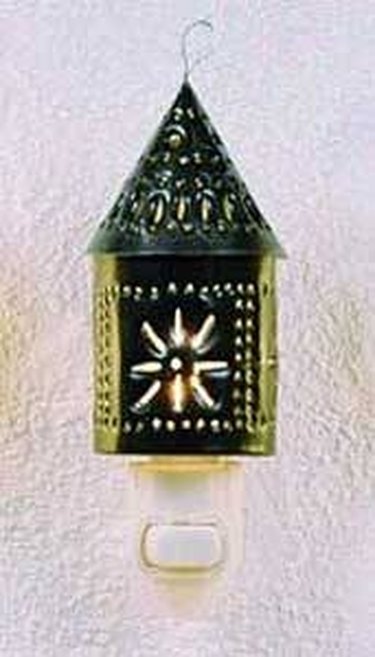
The Patterson brothers, immigrants from Ireland, opened a tinsmith shop in Connecticut in the early 1700s. Sometimes called "poor man's silver," tin became extremely popular in the American colonies because it was inexpensive, lightweight, easy to clean and very durable. Tin punching decorated tinsmithed items and allowed light to emanate from lanterns. During colonial times, tin-punched items were called "pierced ware." Today, pierced ware items continue to sell well, and children across the country participate in tin-punching projects at school.
History
Video of the Day
Tinsmithing became common in England in the 1630s, but the large sheets of tin necessary for making household items had to be imported from Hamburg. Early in the 1700s, long, thin sheets of tin were being produced in England, and England exported this tin to the American colonies.There were no tin deposits in colonial America, and the colonists were not allowed to import raw tin to run their own tin mills until after the American Revolution. By the early 1800s, because the United States could produce the tin themselves, tinsmithing became very popular and common. Peddlers traveled from village to village to sell the wares.
Video of the Day
Types
The most common tinplate used in tin punching is iron coated with tin and then run through roller mills. Unalloyed tin is very soft, too soft for making durable household goods, and it is very expensive as well. One type of tin is alloyed with copper and lead. Technically, this type of tinplate is called pewter. Another type of tinplate is made of tin alloyed with copper alone. This type of tinplate is actually bronze. If you were to do tin punching today, the tinplate you buy for your projects would probably be made of mild steel electroplated with tin. When this process is done well, the tin should never rust.
Features
Tin-punched items were inexpensive during colonial times, much less expensive than silver or crockery. They were also more durable and required less maintenance. Silver items had to be regularly polished to maintain their sheen, but tin items were easy to care of. They were also lightweight, decorative and readily available from peddlers who traveled from village to village.
Identification
Collectors of tin-punched wares today can find a wide variety of items. They may be well worn, and if the item was originally painted it will probably have lost most of its paint. Also, the item may be quite expensive, much more expensive than it was for the original owners. If you are looking for tinsmithed items, keep your eyes open for dippers, cups and measures, spoons, ladles, candle molds, cookie cutters, plates, teakettles and coffee pots. Another treasure is pie cupboards with tin-punched door panels.
You can also identify tinsmithed items in the lighting area. Tin punching was a very popular medium for lanterns, so much so that modern manufacturers are still making them. Tinsmithing was also used for candlesticks. You can differentiate tin candlesticks from others because they are lighter in weight.
Also, look for tin-punched fireplace equipment. Colonial tinsmiths made footstoves, square- or rectangular-handled boxes. They also made woodboxes out of punched tin, and often these came with tin-punched match holders.
Potential
Tin-punching is not just a craft of the past. If you look in modern housekeeping magazines, you'll see many instances of tin punching used as modern house decoration, from cupboard doors to lanterns, chandeliers, and wall art. Also, tin punching is very much alive and well as an art form for school-age children. Tin punching is regularly seen in elementary schools as children study colonial times. Girl and Boy Scouts learn tin punching as a way of honoring their past and taking pleasure in a creative pastime.